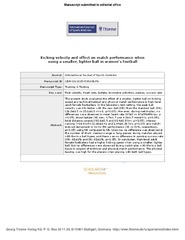Kicking velocity and effect on match performance when using a smaller, lighter ball in women's football
Permanent link
https://hdl.handle.net/10037/10905Date
2016-08-23Type
Journal articleTidsskriftartikkel
Peer reviewed
Author
Andersen, Thomas Bull; Krustrup, Peter; Bendiksen, Mads; Ørntoft, Christina; Randers, Morten B.; Pettersen, Svein ArneAbstract
The present study evaluated the effect of a
smaller, lighter ball on kicking speed and technical-
tactical and physical match performance in
high-level adult female footballers. In the laboratory
test setting, the peak ball velocity was 6 %
higher with the new ball (NB) than the standard
ball (SB) (26.5 ± 0.5 vs. 25.1 ± 0.5 m · s − 1, p < 0.05).
However, during match-play, no differences were
observed in mean heart rate (87 ± 5 vs.
87 ± 5 %HRmax; p > 0.05), blood lactate (90 min:
4.7 ± 1.7 and 4.0 ± 1.7 mmol · l − 1; p > 0.05), total
distance covered (10.6 ± 0.9 and 10.4 ± 0.8 km;
p > 0.05), intense running ( > 16 km/h) (2.08 ± 0.42
and 1.94 ± 0.38 km; p > 0.05) and match-induced
decrement in Yo-Yo IR1 performance (28 vs. 31 %,
respectively, p < 0.05) using NB compared to SB.
Likewise, no difference was observed in the number
of short, medium-range or long passes during
matches played with the 2 ball types, and there
was no difference in passing success rate (NB:
68 ± 1 % and SB: 68 ± 1 %, p > 0.05). In conclusion,
high-level adult female footballers had a higher
kicking speed when using a smaller, lighter ball,
but no differences were observed during matchplay
with the 2 ball types in respect of technicaltactical
and physical match performance. The
physical loading was high for the players when playing with both ball types.
Description
Manuscript. Published version available in International Journal of Sports Medicine, 2016; 37(12): 966-972, doi 10.1055/s-0042-109542


 English
English norsk
norsk